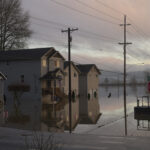The same engineers who captivated tourists and passersby by rappelling down the Washington Monument began a similar operation Monday at the National Cathedral, the other major landmark to be damaged by an earthquake that shook the nation’s capital.
The “difficult access team” from Wiss, Janney, Elstner Associates, Inc. began its work Monday when Emma Cardini emerged at the top of a 234-foot tower. She was joined minutes later by Katie Francis and, using ropes and harnesses, the two women efficiently worked their way down the front of the building.
The inspection is expected to last about two weeks, said Dan Lemieux, who heads WJE’s Fairfax, Va., office and is supervising the project. The engineers are looking for loose, cracked or unstable stones that could pose a risk to people on the ground. Those stones will be removed before the cathedral’s scheduled reopening on Nov. 12.
Last week, stone masons removed 2 tons of stonework from a pinnacle damaged by the 5.8-magnitude earthquake on Aug. 23. Three of the four pinnacles on the 300-foot central tower were severely damaged and the 2-ton section had shifted off its base.
The 4-foot-tall top portions of the pinnacles, called the finials, fell off during the earthquake and crashed onto the cathedral roof. The cathedral sustained additional damage during Hurricane Irene, the Category 1 storm that blew through Washington five days after the quake.
Initial repairs to the cathedral are expected to cost at least $15 million, and the price tag for fully restoring the building remains unknown. The cathedral was completed in 1990 after 83 years of work. A campaign has begun to raise $25 million by the end of 2012.
Four of the five engineers who climbed out windows and a hatch atop the Washington Monument are participating in the cathedral inspection. While the monument descent was more dramatic, the cathedral has more variety, said Erik Sohn, one of the climbers.
“The Washington Monument is such a huge, historic structure, but it’s relatively stark while you’re up there on the side of the building. There’s not a whole lot to look at,” Sohn said. “This, with all the ornamentation that we’re going to be crawling around and touching and feeling, it’s more entertaining for us.”
The engineers will be carrying masonry tools, iPads and other equipment that allows them to inspect the stones, remove them as needed and document their findings.
Cathedral officials are confident that the building will be declared safe well ahead of Nov. 12, when the Rev. Mariann Budde will be consecrated as the ninth bishop of the Episcopal Diocese of Washington, cathedral spokesman Richard Weinberg said. The cathedral will reopen to the public the next day, with Budde presiding over services.
The cathedral, located on one of the highest points in the District of Columbia, is an Episcopal church but pursues a mission of spiritual harmony. It has hosted inaugural services and funerals for several presidents.
Was this article valuable?
Here are more articles you may enjoy.

 NYT, Chicago Tribune Sue Perplexity AI as Copyright War Rages On
NYT, Chicago Tribune Sue Perplexity AI as Copyright War Rages On  Abbott Presses Congress for Shield Over Preemie Baby Formula Litigation That Could Cost It Billions
Abbott Presses Congress for Shield Over Preemie Baby Formula Litigation That Could Cost It Billions  Pacific Northwest Braces for Even More Flooding Rain This Week
Pacific Northwest Braces for Even More Flooding Rain This Week  NYT Asks Judge to Dismiss Trump’s ‘Implausible’ Defamation Suit
NYT Asks Judge to Dismiss Trump’s ‘Implausible’ Defamation Suit 